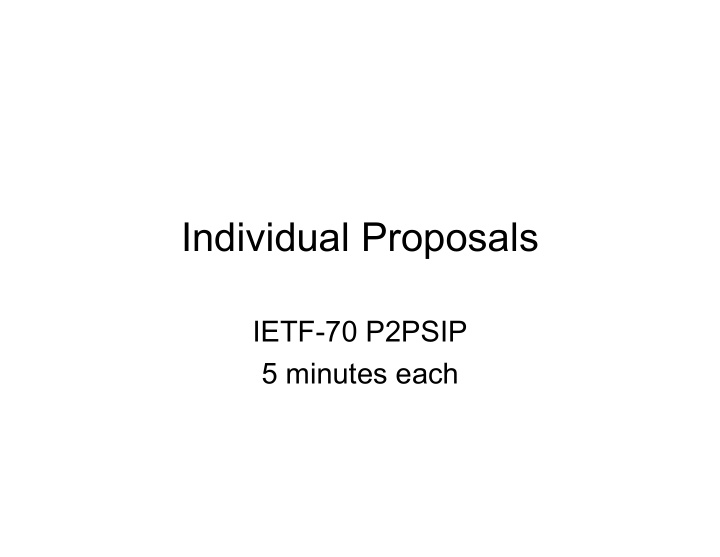



Individual Proposals IETF-70 P2PSIP 5 minutes each
draft-bryan-p2psip-reload-02 C. Jennings, B. Lowekamp, E. Rescorla, J. Rosenberg • merge of RELOAD and ASP proposals • binary protocol – fixed fields where possible, TLV where flexible types are needed • Certificates for Peers and for Users/Resources – Proposed enrollment mechanism – Also PSK technique • TLS/TCP or DTLS/UDP with fragmentation
reload-02 Routing • VIA/Route Log headers with IDs – PeerIDs or opaque local ids for clients/compression • Use ICE – gather candidates over time – CONNECT with ICE – TUNNEL to communicate across overlay • Supports recursive symmetric/asymmetric and iterative routing – Some discussion of pros and cons, more work needed • Service discovery for STUN/TURN servers – assumes predictable percentage of candidates
Peer-to-Peer Protocol (P2PP) • Structured and unstructured • Node and data model – peers, [clients], [enrollment | diagnostic | other server] • Improved hop-by-hop reliability model • Security – peer-ID assignment, routing (TLS, DTLS), storage (signature) • NAT traversal (peer protocol, SIP, media) • Implementation – 500+/100+ nodes Kademlia/Bamboo overlay on ~160 planet lab machines – Mobile phones – Source code release soon
HIP-HOP and ID-LOC Philip Matthews Eric Cooper Alan Johnston Avaya
HIP-HOP and ID-LOC • No new revision of HIP-HOP draft this cycle. – Some open issues still being worked on. • New ID-LOC draft focuses on HIP idea with “biggest bang” for P2PSIP. – “ID / Locator split” concept
ID-LOC • Goals: – Make existing apps work in P2P overlays, often without change – Transparently handle NAT Traversal – Transparently handle Mobility • Key Ideas: – Apps use special IP addresses to identify remote peers – Special addresses then translated to real addresses below transport layer – Dynamically establish a connection, then send packet on connection
Implementation • Use VPN techniques • Packets intercepted by TAP driver and sent to Peer Protocol, which makes necessary adjustments and resends them. App Peer Protocol TCP or UDP / IP TAP driver
Utilizing HIP for P2PSIP (WITH-HIP) draft-hautakorpi-p2psip-with-hip-01.txt Jani.Hautakorpi@ericsson.com Gonzalo.Camarillo@ericsson.com Joakim.Koskela@hiit.fi
Overview • WITH-HIP is not a Peer Protocol proposal • WITH-HIP can be used with Peer Protocols, such as RELOAD and P2PP, for example • WITH-HIP defines how unmodified HIP can be utilized in P2PSIP networks
Why use WITH-HIP? • HIP provides the following functions: – Setup and maintenance of connections between peers – Mobility & multi-homing – Cryptographic host identities – NAT traversal below the application layer
Service Extensible Peer Protocol (SEP) draft-jiang-p2psip-sep-00.txt jiang.x.f@huawei.com hwzheng@huawei.com
Service Advertisement • The Advertisement of the service capability – Each peer encodes its service capabilities; – Each peer advertises the info by using overlay maintenance mechanism; • The peers’ routing states are often organized like the following figure; Transport Address Service Capability Peer ID Peer ID Associated Features Associated Features Processing Status • So the info about service peers has already been advertised through the overlay;
Service Discovery • Discovery Method – The peer in need of a specific service indicates its desire in the request – The intermediate peers and the destination peer collect the info about the service peers; – The source peer MAY get the desirable information in the response; • SEP defines a new message: LookUpServicePeer – It also could be done in a piggyback mode;
NAT Traversal for Semi-Recursive • Semi-Recursive mode – Request is routed hop-by-hop through the overlay; – Response goes back directly to the source peer; • Requirements for relaying peers – MUST be accessed directly by the destination peer; – MUST know how to relay the response to the source peer in the presence of the NATs; • The choice for the Relaying Peers – Neighbor peers with public address; – Any peer with public address; – Etc;
P2PSIP Client Protocol draft-zheng-p2psip-client-protocol-00 jiang.x.f@huawei.com hwzheng@huawei.com
What is Client protocol? • A logical subset of Peer protocol • Provide data storage and retrieval functions thru client’s peer (e.g. GET/PUT/Remove) • Provide connection control function (e.g. Join/Leave) • Provide overlay service redundancy function (e.g. Notify)
Sample Client Peer-1 Peer-2 Join Join-Response Put Put-Response Get Get-Response Leave or busy Notify Notify-Response Join Join-Response
Peer-to-Peer Name Service (P2PNS) draft-baumgart-p2psip-p2pns-00.txt Ingmar Baumgart Institute of Telematics, Universität Karlsruhe IETF 70, Vancouver
Flexibility • Distributed name resolution for: – P2PSIP, decentralized DNS, HIP, decentralized IM (XMPP) • Same task in all scenarios: – Resolve a P2PName (AoR, Domain Name, HIT) to the current transport address (IP, Port) • P2PNS XML-RPC Interface: – register(P2PName, transport address) – resolve(P2PName)
Modular Architecture register() resolve() Name Service • Key Based Routing (KBR) – Task: Message routing to nodeIDs put() – route(key, msg) get() – lookup(key) • Distributed Hash Table (DHT) DHT – Task: Data storage – put(key, value) route() – get(key) lookup() • Name Service KBR – Task: Resolution/Caching of P2PNames – register(P2PName, transport address) – resolve(P2PName) Modular architecture allows to reuse implementations for different applications (ALM, Filesharing, Gaming,…)
Two-Stage Name Resolution 1.) Resolve AoR NodeID (DHT layer) 2.) Resolve NodeID IP (KBR layer) Motivation: – Modification of data records on DHT is expensive (due to security mechanisms) – (AoR, NodeID) binding is static: No modification needed if IP address changes – IP address changes are efficiently handled on KBR layer
P2PNS Security • KBR layer: – Limit nodeID generation (crypto puzzles or offline CA) – Routing over disjoint paths – Secure routing table maintenance • DHT layer: – Replication and majority vote – Only owner may modify data records (nodeID signature) • Prevents identity theft • Unique usernames (same key in DHT is only allowed once) – Insertion DoS attack prevention
Recommend
More recommend